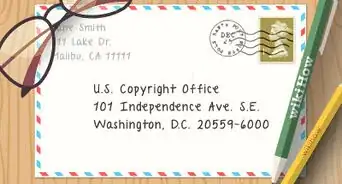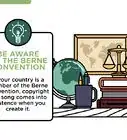This article was co-authored by Clinton M. Sandvick, JD, PhD. Clinton M. Sandvick worked as a civil litigator in California for over 7 years. He received his JD from the University of Wisconsin-Madison in 1998 and his PhD in American History from the University of Oregon in 2013.
There are 9 references cited in this article, which can be found at the bottom of the page.
wikiHow marks an article as reader-approved once it receives enough positive feedback. In this case, 89% of readers who voted found the article helpful, earning it our reader-approved status.
This article has been viewed 176,060 times.
If you have a name or title you'd like to protect, you need a trademark, not a copyright, to ensure that others can't use it without permission. Trademarks distinguish the source of the goods of one party from those of others, while copyrights protect writings, music and works of art. Trademarks in the USA may be registered or un-registered. To protect a trademark, you need to make sure no one else is already using the name by conducting an extensive search, then start using it. To obtain the optional registration, file an application with the United States Patent and Trademark Office, or in one or more US states, and wait to have it approved.
Steps
Doing a Trademark Search
-
1Find out whether your name is strong enough to serve as a trademark. You must determine whether your name, or "mark," is considered strong by the standards of the United States Patent and Trademark Office (USPTO). To be strong, a mark must have a meaning that uniquely represents your product or services and unlikely to be confused with someone else's. The UPSTO divides marks into four different categories, from strongest to weakest, and only the strongest have a chance of getting trademark protection. Here are the categories:[1]
- Fanciful and arbitrary. This is the strongest type of mark, since it's so unusual that there's little chance that someone else would independently think up the same mark and start using it in your field. For example, naming a dog food company "Charcoal" would be arbitrary; naming it "Rovalicious" would be fanciful.
- Suggestive. This is a type of mark that hints at a certain service or product without overtly describing it. For example, naming a t-shirt company "Cotton Candy" would be suggestive.
- Descriptive. This is considered a weak category, since it's obvious enough that other people could easily come up with the same name. For example, calling a copy service "Fred's Copy Service" is too descriptive, and you wouldn't be able to easily protect it as a trademark.
- Generic. This is the weakest category, since generic names are widespread and common, and there would be no way to enforce a trademark protection. For example, naming an ice cream company "Ice Creams and Cakes" is too generic.
-
2Think up related search terms. If you're pretty sure your name falls into a strong category, you need to make sure no one else has already been using it in your field. If they have, you won't be able to use it safely as a trademark and you may have difficult obtaining a registration.
- Start by thinking up search terms related to your name. You'll want to search the exact name as well as names that are pretty close to your name to make extra sure no one has been using or has registered anything like it in your field.
- As a general rule, another brand that has a similar sound, appearance or meaning may lead to yours being "confusingly similar", which would be an infringement. This may be especially true if it is already being used on goods or services related to yours.
Advertisement -
3Use a basic search engine to start your research. First, just use Google® search to find out quickly whether the name is already being used by others. Take special note of results that are similar to your name, even if they aren't identical.
- Note the type of products or services that are associated with similar names and whether they have a ® or a (™) next to the name ---- indicating a proprietary claim.
- If you see your name pop up, or one that is very similar, you may need to come up with a new one to use as your trademark, whether or not you ever want to register it.
-
4Search for the name using the Trademark Electronic Search System (“TESS”) search. You need to search the USPTO's record of registered trademarks to make sure the name isn't already registered or pending. Go to the USPTO website, click on the TESS search page, and search for your name.[2]
- The TESS system allows you to use "wildcard" symbols to check for brands that may differ in various ways, such as misspellings that may sound the same as your brand, or with added suffixes or prefixes.
- You should also check the various state databases of trademarks registered there.
- The mere fact that a brand is not registered, or that its registration has expired, is not a clear indication that it is safe for you to use, since non-registered brands may also be enforced in state or federal courts.
- If you find a similar brand has had an application "abandoned" or "canceled", it may be useful to research more details to understand if yours may suffer the same fate.
-
5Consider working with a trademark attorney. After you've finished the preliminary research, things can get a little tricky. The laws and regulations are numerous and you may want an attorney to assist you with your application. You'll be able to find out whether your name has a good chance of being enforced as a trademark, or being allowed onto the registry, and the attorney can help you navigate the paperwork involved with the application.[3]
- Make sure you work with an attorney who has experience in this particular area. Look online or ask for a referral in order to find a trademark attorney.
- An attorney can be useful whether you believe your brand to be unique or not. Your chances of enforcing your brand or getting it registered as a trademark is higher if you have "done your homework", and that's easier to do with the help of an attorney.
Filing a Trademark Application with the USPTO
-
1Use the interactive web forms or download a trademark application. If you prefer not to use the interactive forms online, the easiest way to get an application is to visit the USPTO website and download a PDF version. You can either send the application to the USPTO by mail or fill it out and submit it electronically.
- You can also obtain the necessary forms by calling the USPTO and having them send you copies.[4] Many people simply have their trademark attorneys do the necessary searching and online filings.
-
2Fill out the application. Follow the instructions outlined on the USPTO website to fill out the Initial Application Form. You'll provide the brand owners name, address, a rendering of the trademark, and a description of what type of product or service you're using it for.[5]
- Classification of your goods and services is an important element of your registration. The USPTO website has links to helpful resource that will assist you in selecting the proper classes and using proper wording to describe your goods or services.
- The interactive online forms have plentiful links to sources of help.
- Make sure you attach all requested documents, including a sample of how you are using the brand on your goods or services.
- If you also want to register the appearance of your logo, as part of the brand, be sure to include an illustration. Many trademarks are primarily "word marks", providing the broadest protection.
- If you have not yet used your brand on goods or services in interstate commerce, you may file an application on the basis of an "intent to use", allowing you several years in which to perfect your claim, once you submit proof of actual use of your brand in commerce.
-
3Submit the application with a filing fee. The filing fee differs depending on how you file, but it will be either $275 or $375 for each class of goods or services you are claiming. You may also choose to file a separate application for each class, as you expand your business. Submit the application using the USPTO website or send it by mail and begin the process.
- The application under "intent to use" is more complicated and somewhat more expensive, but does give you national "priority" over others who attempt to file or use a similar brand after your original USPTO filing date.
- After you submit the application, check the online database to monitor the status of your application. You'll wait several months for the review process to occur. The USPTO examiners will send you a notice when action has been taken on your application.
- The USPTO will contact you if there are any errors in your application, and you should respond promptly to all correspondence. It is very common to have minor errors that can be corrected. Some legal issues may, however, terminate your application, and you may have to start over with a different brand.
- Once your application has been "allowed" because it passes the legal tests to qualify for registration, it will be published for opposition by anyone who may believe they can prove their rights will be damaged by issuance of your registration.
- If there is no opposition timely filed, or you overcome their objections, and you have submitted proof of actual use in commerce, you will be issued a registration certificate.
- Note that a foreign applicant may skip the requirement to prove "use in commerce", based upon one or more exceptions in the US laws and regulations.
-
4Enforce your trademark. Do not use a registered trademark symbol ® until your trademark has been registered and approved by the USPTO. You may use (™) on any brand, including non-registered or those registered only in one or more states. Once your trademark application is approved, it's up to you to use ® on your brand and to enforce it. The USPTO won't be tracking whether other people try to use it. If you see someone using it, you're responsible for taking legal action to enforce your mark.
- To take action against someone using the same or similar mark, start by sending a "cease and desist letter." Within the letter, inform the other party that they are using a protected trademark and that if they do not stop using the mark you will bring a lawsuit against them. If they continue to use the mark despite your letter, you can sue them in state or federal court to stop the improper use.[6] Ask an intellectual property attorney if you have any questions about filing a lawsuit.
- The USPTO will generally reject later applications by others for registration of brands similar to yours, as long as you continue to pay the fees necessary to maintain your USPTO registration. Fees are due in year 5 and year 9, to avoid cancellation.
- Even if your registration is refused or later canceled, you may still be able to enforce your brand in state or federal courts, depending upon why it was refused or canceled. Under US laws, trademark registration is completely optional, as a condition of enforcement, unlike copyright.
Protecting Your Work with a Copyright
-
1Decide if you need to register a copyright. As suggested above, copyright laws apply specifically to original works of creative authorship, not names. If you create a book, computer program, play, poem, song, photograph or other visual work, or another artistic piece, it is copyrighted when you create it. The purpose of a further copyright registration is to verify the validity and to claim authorship of a work or body of work. This legal step provides a legal basis for further claims against illegal infringement.[7]
- Although you do not need to register in order to have a copyright, a registered copyright provides legal evidence of your ownership claim and enters your work into the public record. You are not able to file an infringement suit in US federal court if you don’t have a registered copyright, unless your claim is based upon a foreign copyright.
-
2File a claim to register your copyright. The process involves three actions, all of which can be done online, by mail, or in person. In this case you'll be working with the US Copyright Office, not the USPTO.[8]
- Complete an application form with the U.S. Copyright Office[9]
- Submit a nonrefundable filing fee
- Supply a "deposit" copy of your work to the Copyright Office (i.e., an online upload or an approved form of "hard" copy).
-
3Wait for notification. Whether or not you file for a copyright on paper or online, you will eventually be contacted by the Copyright Office in some form or another. For example, a staff member will contact you if more information is needed, or if your application cannot be accepted for other reasons. If your application is accepted, you will eventually receive a certificate of registration.[10]
- As with trademarks, it is up to the owner of a copyright to monitor for misuse by others and to take action to stop them, as necessary.
Warnings
- Apply online if at all possible so that you can track the progress of your application. The U.S. Patent & Trademark Office receives more than a half a million applications every year; if you apply using a paper application, you will not receive an acknowledgement. However, you can know your application was received by the patent office if you send it via registered or certified mail and request a receipt.⧼thumbs_response⧽
- A United States copyright extends to hundreds of other countries, by various treaties. Check the national laws of each country to be sure your work is protected; if it is not, take the necessary steps to enforce your copyright in those countries.⧼thumbs_response⧽
- When you register your trademark with the federal government, you have evidence of legal ownership in the United States; some countries may have a signed agreements with the United States, if not, you may have to register your trademark in those countries as well. The Bern Convention prohibits its members from requiring any sort of "formalities" like that.⧼thumbs_response⧽
- As long as you use your registered trademark when selling or referring to your product, you are protected; no one can use the name in a way that creates a likelihood of confusion, without your permission (e.g., under a franchise or other license). If you stop using your brand, registered or not, you lose the right to enforce it, under US law.⧼thumbs_response⧽
- When reduced to mailing papers, many practitioners enclose a stamped, self-addressed postcard, which the USPTO mail room will date-stamp and return. There are also many types of filings for which the use of USPS "Priority Mail Express" service will give you a filing date when you deposit the mail.[11]⧼thumbs_response⧽
- A copyright does not protect facts, ideas, systems, discoveries, or methods of operation.⧼thumbs_response⧽
References
- ↑ http://www.uspto.gov/trademarks/index.jsp
- ↑ https://www.uspto.gov/trademarks/search
- ↑ http://www.uspto.gov/trademarks/law/index.jsp
- ↑ http://www.uspto.gov/trademarks-getting-started/trademark-basics/how-do-i-file-trademark-application
- ↑ https://www.uspto.gov/trademarks/apply
- ↑ http://www.nolo.com/legal-encyclopedia/enforcing-trademark-rights-29902.html
- ↑ https://www.copyright.gov/help/faq/faq-register.html
- ↑ https://www.copyright.gov/help/faq/faq-register.html
- ↑ http://www.copyright.gov/forms/
- ↑ https://www.copyright.gov/help/faq/faq-register.html
- ↑ [1] 37 CFR § 1.6
About This Article
If you have a name or brand you'd like to protect, you need a trademark, rather than a copyright, to limit its use by others. To create a US trademark, you need to make sure no one else is already using a similar brand name in your field, then start using it on your goods or services. Next, for better protection and enforceability, you may register your trademark at a state or federal level. Submit a trademark application through the U.S. Trademark Office's website and attach the requested documents. Alternatively, you can print out the application and mail it in to the trademark office along with the filing fee. For tips from our Legal reviewer on how to protect a book, play, or song with a copyright, read on!






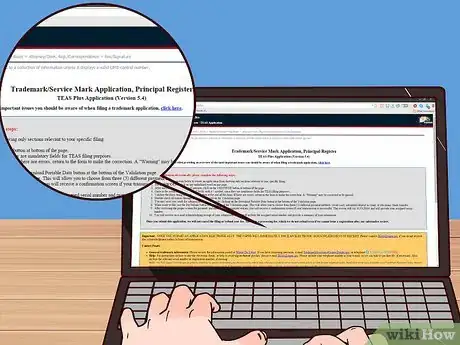

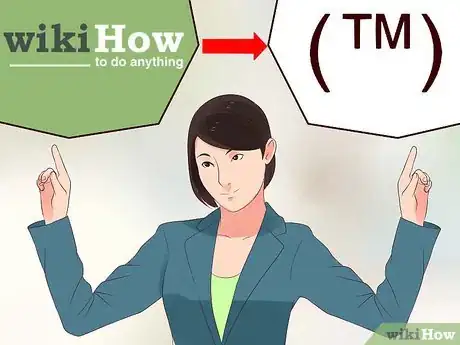


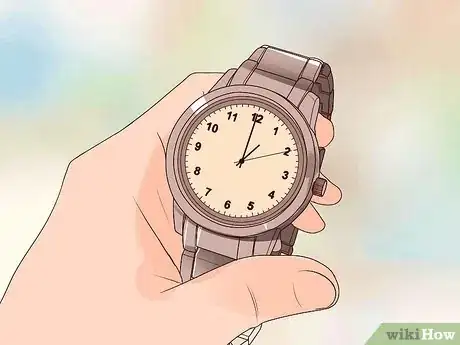



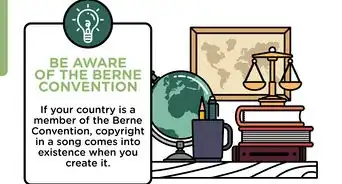





-Step-13.webp)
